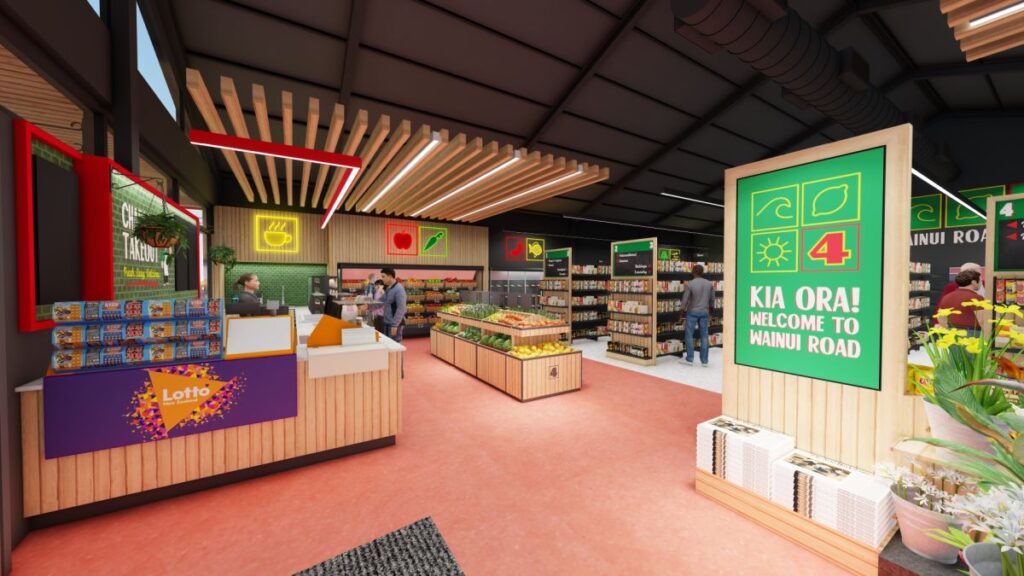Home / Racking and Shelving Insights / Do store refreshes lead to increased sales? We investigate.

With the recession dragging on, we explore how top New Zealand companies are driving growth through store upgrades.
Four Square, Z Energy, The Warehouse, and Supercheap Auto are currently refreshing their network of stores. We dove into their latest annual reports to uncover how these refreshes fit into their growth strategies.
One might expect that a recession would be the worst time to invest in a store refresh. However, that’s precisely what Four Square, Z Energy, The Warehouse, and Supercheap Auto are doing.
So, why might they consider a recession to be an optimal time to spend money?
How a store refresh can lead to increased sales:
Four Square is focused on creating the next generation of Four Square stores by repositioning the brand with a new identity. Essentially, they want to change the consumers’ perception of Four Square to that of a small supermarket rather than a large dairy.
Beginning in 2023, Foodstuffs committed to rolling out its new store format nationwide. The rollout will continue into 2025.
How will this refresh drive growth?
By expanding their product range with fresh produce, barista-made coffee, hot food, and café items like slices and doughnuts. This will differentiate Four Square from typical dairies while setting them up as a more convenient option than supermarkets.
According to Z Energy’s latest annual report, Z’s retail site refresh creates “a cleaner, more modern and consistent offer for customers.” With the refresh beginning in 2022, the rollout is expected to continue through 2025.
What’s changing?
Coffee and hot food will now be available for purchase at a specially designed retail area called Z Express.

Z has also committed itself to offering quality coffee. Gone are the push-button, automated coffee machines. In their place are high-quality European espresso machines with baristas making fresh coffee.
How will this refresh drive growth?
With increased demand for coffee and food, Z will remove bottlenecks from people all queueing at the same checkout, whether for pre-ordered coffee or fuel. Coffee and hot food will now be available for purchase at a specially designed retail area called Z Express. The bottleneck will also be further reduced by allowing customers to pay at the pump or via the Z app. Reducing wait times means that Z will be able to service more customers.
Across Australia and New Zealand, Supercheap Auto has poured millions of dollars into the ongoing refurbishment of its network of stores (2024 Annual Report). This refurbishment signals its “next-generation format”.
Why the new format?
Supercheap has invested in developing emerging product categories arising from electric vehicles. This means they expect to expand their core range. They have also identified that the average vehicle age is increasing, allowing them to grow their core product range.
Supercheap Auto’s revenue grew by 3%, and they are using this next-generation store format and new product categories to further their growth.
It’s been a tough year for The Warehouse Group. After offloading the unprofitable Torpedo7 for just $1, their lead brand, The Warehouse, has seen a 5.3% decline in revenue and a 75.3% decline in operating profit.
Group CEO John Journee says his primary focus in the short term is turning around The Warehouse’s performance and reasserting its customer value proposition and market position (2024 Annual Report).
One of several options chosen to achieve this is by resetting store layouts in key locations. They hope it will improve the customer experience and highlight their improved product offer.
The annual report doesn’t go into much detail about the “improved product offer”. However, it highlights that pantry essentials, health and beauty products, and baby and pet care are proving popular with more frequent shopping habits.
We expect The Warehouse to expand this range with store layouts designed to highlight these products.
In the face of economic uncertainty, Four Square, Z Energy, Supercheap Auto, and The Warehouse are making bold moves to refresh their stores, demonstrating that innovation and strategic investment can be powerful tools for growth—even during a recession.
By modernising their spaces, enhancing customer experiences, and aligning product offerings with evolving consumer preferences, these companies are positioning themselves not only to survive but to thrive in the long term. Store refreshes are more than cosmetic upgrades; they represent a forward-looking strategy to capture market share, foster brand loyalty, and adapt to shifting market dynamics.
The common thread across these examples is clear: companies willing to invest in their customer experience, even in tough times, are better equipped to emerge stronger when the economy rebounds. Whether it’s reimagining Four Square as a small supermarket, elevating Z Energy’s café experience, expanding Supercheap Auto’s product range, or reasserting The Warehouse’s value proposition, these strategies highlight the importance of staying agile and customer-focused.
Ultimately, the success of these refreshes will hinge on their ability to resonate with consumers and drive measurable sales growth. For now, these efforts serve as a case study in how businesses can turn challenges into opportunities, setting the stage for sustainable growth in the years to come.